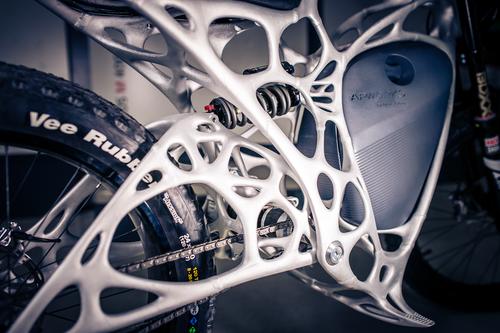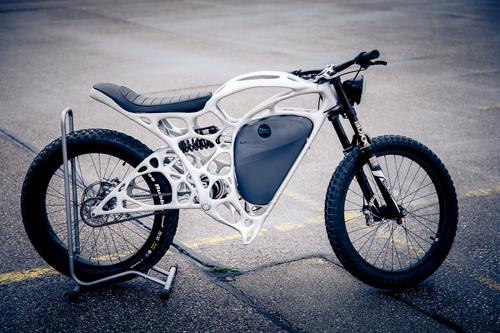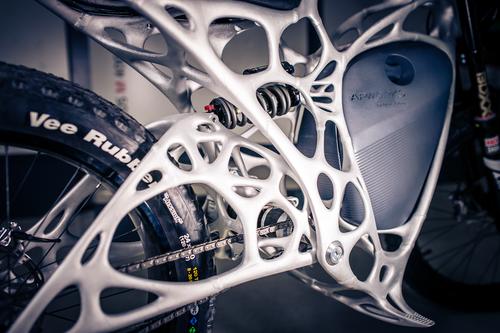Electric Motorcycle Is 3D Printed ... with Metal 14568
June 14, 2016

It's probably too late to buy one, but some lucky people will soon be the owners of only 50 electric motorcycles made entirely with 3D printing from a super-lightweight aluminum alloy. The Light Rider was made by engineers at Germany's APWorks. Their day jobs are designing and building bionically optimized metal parts using additive manufacturing (AM) for all kinds of aerospace, automotive, and robotics products.

The motorcycle's frame looks more like an exoskeleton than a traditional machine, with organic shapes that are characteristic of what happens when you combine the geometrical design freedom of 3D printing with optimization software. The engineers at this wholly owned subsidiary of Airbus in fact used bionic algorithms to define the frame's structure with Altair's OptiStruct. This guaranteed the optimal use of material and provided the frame's structure with high stiffness.
The frame was built from thousands of 60-micron layers in a metallic powder bed using laser powder bed AM, and weighs only 6 kg (13 lb). It's made entirely from Scalmalloy, an aircraft-grade, corrosion-resistant aluminum-magnesium-scandium alloy developed for AM by APWorks in collaboration with Airbus Group R&D. Its hollow parts make it possible to integrate cables, pipes, and screw-on points in the final structure, further reducing the bike's weight.
This alloy has nearly the specific strength and ductility of titanium plus the light weight of aluminum, and is twice as strong as the AlSi10Mg aluminum-silicon powder widely used in AM. Scalmalloy also has exceptional fatigue and toughness properties, as you can see in the MDS here.
All this makes the Light Rider probably the world's lightest motorcycle, says APWorks: it weighs only 35 kg (77 lb), 30% lighter than conventionally manufactured electric motorcycles. It's got a power-to-weight ratio equal to that of a supercar. The bike is powered by a 6 kW electric motor that takes it from zero to 80 km per hour in a few seconds.

APWorks' engineers programmed the optimization algorithm to develop a strong but lightweight structure based on bionic structures and natural growth processes and patterns. So the Light Rider's organic look was a deliberate design goal, says the company's CEO, Joachim Zettler.
"The complex and branched hollow structure couldn't have been produced using conventional production technologies such as milling or welding," Zettler said. "Advances in additive layer manufacturing have allowed us to realize the bionic design we envisioned for the motorcycle without having to make any major changes."
The Light Rider is going for 50,000 euros with a 2,000 euro deposit. It may not be the first fully functional 3D-printed motorcycle -- that would be the one built by TE Connectivity last year as a demonstrator, to show what AM can do in making plastic load-bearing production parts. True, not every part of that motorcycle was 3D-printed: exceptions were obvious ones like the motor, side mirrors, the battery, electronics, and brake system. But the Light Rider is definitely the first one built of metal, and of such an amazing metal, as well as one with such a beautifully optimized design.
[images via APWorks]
READ MORE ARTICLES ON 3D PRINTING:
Ann R. Thryft is senior technical editor, materials & assembly, for Design News. She's been writing about manufacturing- and electronics-related technologies for 28 years, covering manufacturing materials & processes, alternative energy, and robotics. In the past, she's also written about machine vision and all kinds of communications.
About the Author(s)
You May Also Like



